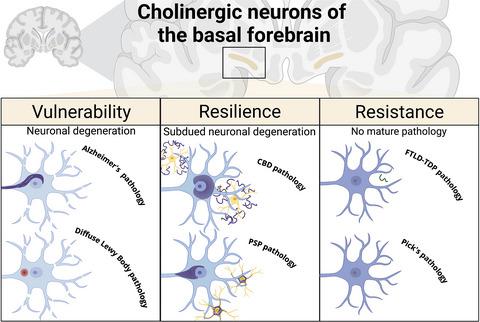当前位置:
X-MOL 学术
›
J. Neurochem.
›
论文详情
Our official English website, www.x-mol.net, welcomes your
feedback! (Note: you will need to create a separate account there.)
Basal forebrain cholinergic system in the dementias: Vulnerability, resilience, and resistance
Journal of Neurochemistry ( IF 4.2 ) Pub Date : 2021-07-17 , DOI: 10.1111/jnc.15471 Changiz Geula 1 , Sara R Dunlop 1 , Ivan Ayala 1 , Allegra S Kawles 1 , Margaret E Flanagan 1 , Tamar Gefen 1 , Marek-Marsel Mesulam 1
Journal of Neurochemistry ( IF 4.2 ) Pub Date : 2021-07-17 , DOI: 10.1111/jnc.15471 Changiz Geula 1 , Sara R Dunlop 1 , Ivan Ayala 1 , Allegra S Kawles 1 , Margaret E Flanagan 1 , Tamar Gefen 1 , Marek-Marsel Mesulam 1
Affiliation

|
The basal forebrain cholinergic neurons (BFCN) provide the primary source of cholinergic innervation of the human cerebral cortex. They are involved in the cognitive processes of learning, memory, and attention. These neurons are differentially vulnerable in various neuropathologic entities that cause dementia. This review summarizes the relevance to BFCN of neuropathologic markers associated with dementias, including the plaques and tangles of Alzheimer's disease (AD), the Lewy bodies of diffuse Lewy body disease, the tauopathy of frontotemporal lobar degeneration (FTLD-TAU) and the TDP-43 proteinopathy of FTLD-TDP. Each of these proteinopathies has a different relationship to BFCN and their corticofugal axons. Available evidence points to early and substantial degeneration of the BFCN in AD and diffuse Lewy body disease. In AD, the major neurodegenerative correlate is accumulation of phosphotau in neurofibrillary tangles. However, these neurons are less vulnerable to the tauopathy of FTLD. An intriguing finding is that the intracellular tau of AD causes destruction of the BFCN, whereas that of FTLD does not. This observation has profound implications for exploring the impact of different species of tauopathy on neuronal survival. The proteinopathy of FTLD-TDP shows virtually no abnormal inclusions within the BFCN. Thus, the BFCN are highly vulnerable to the neurodegenerative effects of tauopathy in AD, resilient to the neurodegenerative effect of tauopathy in FTLD and apparently resistant to the emergence of proteinopathy in FTLD-TDP and perhaps also in Pick's disease. Investigations are beginning to shed light on the potential mechanisms of this differential vulnerability and their implications for therapeutic intervention.
中文翻译:

痴呆症中的基底前脑胆碱能系统:脆弱性、恢复力和抵抗力
基底前脑胆碱能神经元(BFCN)提供人类大脑皮层胆碱能神经支配的主要来源。它们参与学习、记忆和注意力的认知过程。这些神经元在导致痴呆的各种神经病理实体中存在不同程度的脆弱性。本综述总结了与痴呆相关的神经病理学标志物与 BFCN 的相关性,包括阿尔茨海默病 (AD) 的斑块和缠结、弥漫性路易体病的路易体、额颞叶变性的 tau 蛋白病 (FTLD-TAU) 和 TDP- 43 FTLD-TDP 蛋白病。这些蛋白质病中的每一种都与 BFCN 及其离皮质轴突有不同的关系。现有证据表明,AD 和弥漫性路易体病中 BFCN 存在早期且严重的退化。在 AD 中,主要的神经退行性相关因素是神经原纤维缠结中磷酸化蛋白的积累。然而,这些神经元不太容易受到 FTLD 的 tau 蛋白病的影响。一个有趣的发现是,AD 的细胞内 tau 蛋白会导致 BFCN 的破坏,而 FTLD 则不会。这一观察结果对于探索不同种类的 tau 蛋白病对神经元存活的影响具有深远的意义。FTLD-TDP 的蛋白病显示 BFCN 内实际上没有异常内含物。因此,BFCN 非常容易受到 AD 中 tau 蛋白病的神经退行性影响,对 FTLD 中 tau 蛋白病的神经退行性影响有弹性,并且对 FTLD-TDP 中甚至皮克氏病中蛋白质病的出现具有明显的抵抗力。调查开始揭示这种不同脆弱性的潜在机制及其对治疗干预的影响。
更新日期:2021-09-22
中文翻译:

痴呆症中的基底前脑胆碱能系统:脆弱性、恢复力和抵抗力
基底前脑胆碱能神经元(BFCN)提供人类大脑皮层胆碱能神经支配的主要来源。它们参与学习、记忆和注意力的认知过程。这些神经元在导致痴呆的各种神经病理实体中存在不同程度的脆弱性。本综述总结了与痴呆相关的神经病理学标志物与 BFCN 的相关性,包括阿尔茨海默病 (AD) 的斑块和缠结、弥漫性路易体病的路易体、额颞叶变性的 tau 蛋白病 (FTLD-TAU) 和 TDP- 43 FTLD-TDP 蛋白病。这些蛋白质病中的每一种都与 BFCN 及其离皮质轴突有不同的关系。现有证据表明,AD 和弥漫性路易体病中 BFCN 存在早期且严重的退化。在 AD 中,主要的神经退行性相关因素是神经原纤维缠结中磷酸化蛋白的积累。然而,这些神经元不太容易受到 FTLD 的 tau 蛋白病的影响。一个有趣的发现是,AD 的细胞内 tau 蛋白会导致 BFCN 的破坏,而 FTLD 则不会。这一观察结果对于探索不同种类的 tau 蛋白病对神经元存活的影响具有深远的意义。FTLD-TDP 的蛋白病显示 BFCN 内实际上没有异常内含物。因此,BFCN 非常容易受到 AD 中 tau 蛋白病的神经退行性影响,对 FTLD 中 tau 蛋白病的神经退行性影响有弹性,并且对 FTLD-TDP 中甚至皮克氏病中蛋白质病的出现具有明显的抵抗力。调查开始揭示这种不同脆弱性的潜在机制及其对治疗干预的影响。











































 京公网安备 11010802027423号
京公网安备 11010802027423号